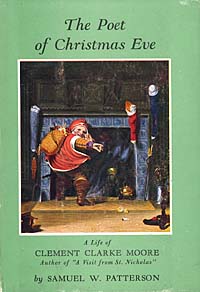PITTSBURG - Santa Claus riding a hot pink sleigh, sharing a pipe with an Indian chief, or wearing Levi jeans and a 10-gallon Stetson.
These are a few interpretations of old Saint Nick that can be found in a large collection of "'Twas the Night before Christmas" and other
Christmas books on display at Carnegie Mellon University's fine arts library.
While larger collections of the poem can be found, Carnegie Mellon acquired its rich collection of nearly 400 books from Anne Lyon Haight, a bibliophile who wrote
a reference book on banned books. University officials say Haight was inspired to start the collection in the 1930s because of her children.
Because Haight started collecting early, she was able to preserve a wide range of editions from different eras, making the collection hard
to match today, said Nancy H. Marshall, author of "The Night before Christmas: A Descriptive Bibliography of Clement Clarke Moore's
Immortal Poem."
"It's a standard many of us dream of because she was able to do what no one will be able to do now," said Marshall, 71, of Williamsburg, Va.
Marshall has one of the largest private collections of the poem at 1,300, but is lacking some of the earliest editions found in Carnegie Mellon's Hunt Library.
Marshall, a now-retired former College of William and Mary library dean, plans to eventually donate her collection to the school. She says it will top the University
of North Carolina at Chapel Hill's 1,000-piece collection and the hundreds at Brown University.
Carnegie Mellon's collection has grown since the library acquired it in 1982 following Haight's death. It includes a copy of the original 1823 poem
that appeared in The Troy (N.Y.) Sentinel, as well as toy books printed in 1864.
There are parodies of the poem and tales of Santa traveling the globe. There are children's cookbooks, a play of Norman Corwin's
"The Plot to Overthrow Christmas," and a short story of Washington Irving's "The Christmas Dinner."
The collection is dominated by the famous poem, all in English except for one book in French. Reflecting nearly two centuries of
Christmas, the collection's caretakers say cultural experts and historians are able to see the evolution of Santa Claus through
illustrations accompanying the poem.
"The illustrations are almost always showing a nostalgic view of life in the United States," said Mary Kay Johnsen, the special
collections librarian at the Hunt Library.
"The illustrations are always showing toys of the parents' generation, not of the toys the kids
would be receiving with the book of that year."
The illustrations in the books often reflect America's materialistic culture. Even in the early 1900s, children can be seen
hanging up their "union suits" - or one-piece long underwear - instead of stockings.
"The illustrations show the children are canny and maximize their loot," Johnsen said.
Books in the 1920s had a touch of art deco and rich watercolors were used in books from the 1930s. The psychedelic 1960
delivered Santa in a hot pink sleigh. Technology is often deleted from the illustrations. Rarely do telephone wires appear, Johnsen said.
While the first illustrated versions of Santa Claus dated back to 1840 with Santa wearing a fur hat, fur jacket and knee britches, Thomas Nast is
credited with creating the modern image of Santa Claus on the cover of Harper's Weekly in 1862.
Although "'Twas the Night Before Christmas" was first published anonymously as "A Visit from St. Nicholas," the poem is most commonly
credited to Clement Clarke Moore, a Bible professor in New York City.
Descendants of Henry Livingston have insisted it was the Revolutionary War veteran who penned the popular holiday poem.



![]() Copyright © 2014, InterMedia Enterprises
Copyright © 2014, InterMedia Enterprises